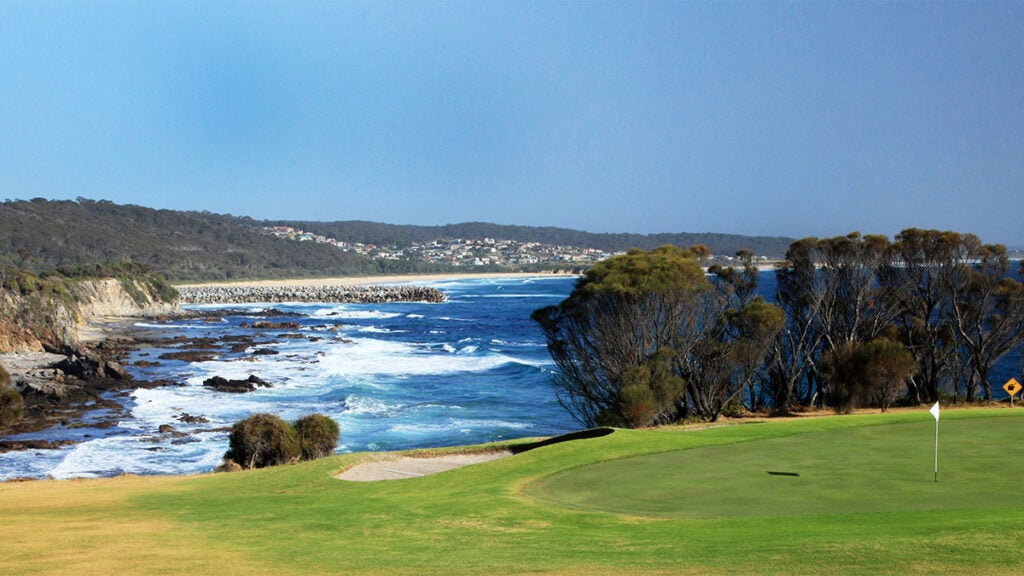Weather is always the X factor in tournament golf. It affects everything. Course conditions and playability. Setup. Scoring. Pace of play. Good weather or bad. Doesn’t matter. Weather has an undeniable impact.
It dictates.
RELATED: J.J. Spaun is an incredible story that won an unforgiving US Open via an improbable finish
What occurred on the final day of the US Open at Oakmont Country Club is that J.J. Spaun, a loveable and unlikely upstart, won the championship. He is a deserving winner. He beat the so-called “Ugly Monster”, (as players of yesteryear were wont to call Oakmont) on an inhospitable day with a final-round, two-over 72 and one-under 279 aggregate score – the only man to finish under par. The guy birdied the last two holes, only the fifth winner ever to do that. He beat a world-class field and handled a legendary layout, winning by two shots over Robert MacIntyre.
We’d be remiss if we didn’t give some kudos to the USGA for a proper setup over 72 holes that proved the supreme examination it was supposed to be.
But now for some serious head-scratching. This is in regard to the aforementioned X factor.
The rainstorm that was expected to descend on Oakmont indeed found its menacing way over the championship, causing a suspension of play at 4:01pm, local time, for one hour and 36 minutes. Another deluge unloaded on the championship starting at 6:10pm. It could have all been avoided with an early start of threesomes off both the first and 10th tees. And probably should have been. Start times from 8am to 10am with 11-minute intervals would have determined a winner by 3:45pm – and that’s allowing for rounds of 5:45, a generous pace of play.
Allow us to present an argument from a purely competitive perspective.
First, though, a point of fact. The PGA Tour is not averse to moving up tee-times, sending players off both tees, in an effort to beat inclement weather and determine a champion on Sunday. It doesn’t always work out, but the tour recognises the importance of getting things done, with safety being paramount.
Safety was not an issue here, beyond the odd slip-and-slide that had existed since the monsoon that struck Oakmont late on Friday. Let’s be clear about that. No golf organisation in its right mind would subject players, spectators, volunteers and support workers to a dangerous situation. So, no quarrel there.
But the upshot of avoiding bad weather is the benefit of having a relatively equal set of course conditions intended to account for a certain set of elements.
Granted, this wasn’t the case when late starters were approaching the finish on Friday and played in some heavy rain before the round was suspended. Changing conditions are part of tournament golf. And it certainly can lead to unequal outcomes. But competitors only encountered adverse weather for a short time. And it wasn’t the final round, when the championship is on the line.
The USGA got lucky with the weather on Saturday, and it hoped to get lucky on Sunday. The forecast wasn’t much different. Still, that was asking a lot.
John Bodenhamer, chief championships officer for the USGA, was not available for comment according to a spokesperson. Asked about the decision on the tee-times and whether consideration was given to moving them earlier, the spokesperson said, “No comment. We have a great champion.”
The best move was to start early, for no other reason than to preserve the integrity of the competition as much as possible. Playing conditions were so markedly different after storm clouds moved in that any reasonable observer could see that most players who returned after the suspension struggled with the new course paradigm.
Spaun, however, was not among them. He played his remaining 10 holes in three-under par. Impressive stuff.

Photo: Andy Lyons
Golf is inherently unfair. This isn’t about fairness or unfairness but presenting essentially a uniform challenge that reflects the same high standards the USGA strives to achieve in its setups. The USGA had done a remarkable job testing every aspect of a player’s game at Oakmont, but it sacrificed much of its good work not adjusting plans for an ominous weather pattern.
Nowhere was it more obvious how the conditions had changed drastically than when the final pairing of Sam Burns and Adam Scott reached the 11th hole. Their drives landed and advanced no further, with Burns’ ball seemingly backing up and then tumbling into the intermediate rough. Scott’s second shot from the fairway flew the green into high native grass because the ball hydroplaned off his clubface. Scott managed to eke out a bogey after he barely moved his third shot forward.
“Once the fairways were soaked, it was very hard to control the golf ball,” said Scott, 44, who lamented that he wasn’t the same golfer after the restart. “It was borderline unplayable. The water was, like, so close to the surface. Like the shot I hit on 11, it’s bizarre. It was like an aquaplane on the ground. It’s a tough call, but we played. Everyone had to deal with it.”
No, they didn’t. Some played a few holes in it, some more than half their round. Some not at all, like 2021 champion Jon Rahm, who tied Rory McIlroy for low round of the day with a 67. That enabled the Spaniard to garner a nifty backdoor top-10 finish.
Burns encountered similar water issues at the 11th out of a thick lie just outside a greenside bunker. He made a double-bogey. And then at the 15th hole, Burns asked for relief from casual water but didn’t get it. His shot went left when “water got in the way”. The Louisianan suffered another double-bogey to drop to three-over, and his hopes were all but dashed. Or drowned.
The pacesetters as the start of the day would go on to finish well back, with Burns shooting 78 for a 284 total, tied for seventh, and Scott tumbling to T-12 with a 286 total after a 79 – costing him by one stroke a top-10 finish and an automatic return to the US Open next year in what looks to be his 100th consecutive major-championship appearance.
Did television play some role in the decision to stay with the status quo? Logic says so. It was thought that TV had an impact on what transpired at the 2005 PGA Championship at Baltusrol where the PGA of America failed to adjust its starting times for the final round despite imminent thunderstorms. Phil Mickelson capped his victory on a Monday morning with a fraction of fans watching at home or in person.
Playing conditions can always change throughout the day. There can be no denying that. A course dries out. Wind kicks up or dies down. A tournament is a living, breathing thing contested among fallible human beings. It can’t really be controlled. “Outdoor sport,” world No.1 Scottie Scheffler deadpanned when the subject was broached.
No, it can’t be controlled. But it certainly can be managed.
The point we’re making is to try to do right by the entire field, if at all possible, when the magnitude of a championship like the US Open is on the line. And it was possible.




